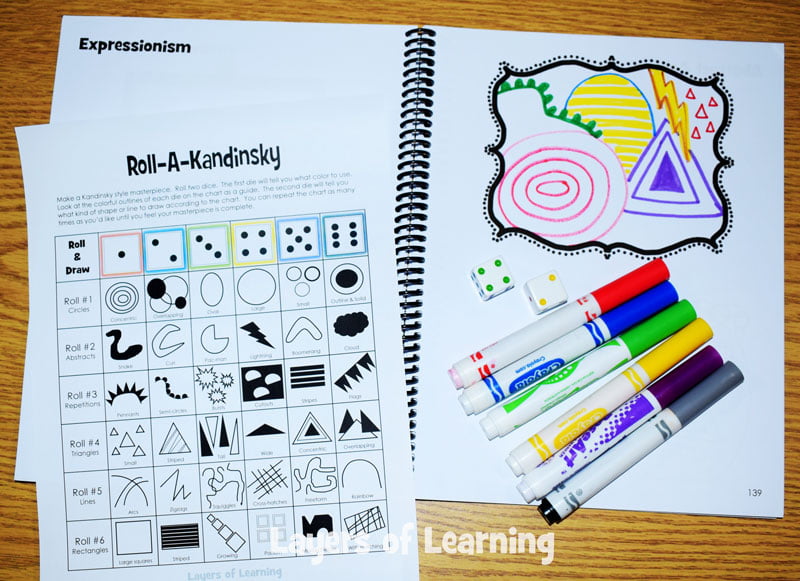This exploration is for all ages, as the colored smilies show. You can do the Roll-A-Kandinsky exploration with your whole family together.




The Roll-A-Kandinsky art exploration is from Modern Movements. Within the unit, you will find lots more hands-on projects and explorations to help your family learn all about the Expressionist movement, painters, and how all of it tied into the world being at war during this time period. Layers of Learning has hands-on explorations, experiments, and art projects in every unit of this family-friendly curriculum. Learn more about Layers of Learning.
The Expressionist art movement was a modern art movement that gained momentum at the beginning of the 20th century. It coincided with World War I and was a creative expression of the turmoil of the times. Expressionist art was based on emotion. Artists of the time didn’t feel the need to paint a lovely scene or an accurate portrayal of a person. Instead, they wanted to paint a feeling, and they wanted their viewers to feel the same thing.

Wassily Kandinsky was a Russian painter who pioneered completely abstract paintings. Abstract paintings aren’t pictures of objects at all. Kandinsky was a spiritual painter who wanted everyone to feel deeply poignant and personal feelings when they looked at art, much in the way that music often reaches into us. He believed color held symbolism that could create a spiritual experience for artists and viewers. The longer Wassily Kandinsky painted, the more colorful and abstract his paintings became. He began including geometric shapes more and more in his paintings, as you can see in Circles in a Circle, created by Kandinsky in 1923.
Step 1: Library Research
Before you begin the project, read a book or two about Expressionism. You don’t need to find these specific titles, but here are a few we recommend. The colored smilies above each book tell you what age level they’re recommended for.
As Amazon affiliates, the recommended books and products below kick back a tiny percentage of your purchase to us. It doesn’t affect your cost and it helps us run our website. We thank you!

Name That Style
by Robert Raczka


Expressionism
by Norbert Wolf

Step 2: Roll-A-Kandinsky
You’ll need markers, dice, your Art Sketchbook, and the Roll-A-Kandinsky printable.
Now, make your own Kandinsky-style artwork in your Art Sketchbook. First, you will roll two dice. Then, use the roll to determine what you will draw. For example, on Roll #1, if you rolled a four and a one, you would use a yellow marker because yellow is shown on the number four die. The second die you rolled, the one, tells you to draw concentric circles (column #1) using that yellow marker. The first die will determine the color you use and the second die will determine the shape or line you draw. Roll six times, each time adding another colorful element to your Kandinsky-style artwork in your Art Sketchbook.

Step 3: Show What You Know
Finally, show off your Kandinsky-style art to an audience and tell about the difference between representational and abstract art. Share some things you learned from your reading about Wassily Kandinsky and other Expressionist painters.
Additional Layers
Additional Layers are extra activities you can do or tangents you can take off on. You will find them in the sidebars of each Layers of Learning unit. They are optional, so just choose what interests you.
Writer’s Workshop

Franz Marc was another Expressionist painter who used color creatively. Choose your favorite animal and draw it. If you could have that animal in any color, which would you choose? It doesn’t have to be realistic. You could have a purple bunny rabbit or an orange and pink striped zebra. Maybe it’s a yellow monkey. Write a little about your choice and what that animal and color mean to you.
Additional Layer

Vincent Van Gogh did much to pave the way for Expressionism. Compare some of his paintings to some of the paintings of Expressionists. Can you find any similarities in style, color, line, shape, or tone?
Fabulous Fact

Wassily Kandinsky, Photo by an unknown author, Public domain, shared via Wikimedia Commons
Kandinsky had been a teacher of law before he went to art school. He kept teaching after becoming an artist. He founded an art association that included an art school. He continued to teach classes and workshops on painting and color theory throughout his career. He studied and wrote about color, line, and shape, painting all the while.
Get a Free Unit
Choose between the first unit in each Layers of Learning subject to try for free when you sign up for the newsletter.
We never spam and you can cancel your subscription at any time.








Est ce que je peux l’utiliser pour mes élèves en classe. 88 copies
Oui bien sûr. Vous êtes invités à utiliser autant de copies que nécessaire pour votre classe.